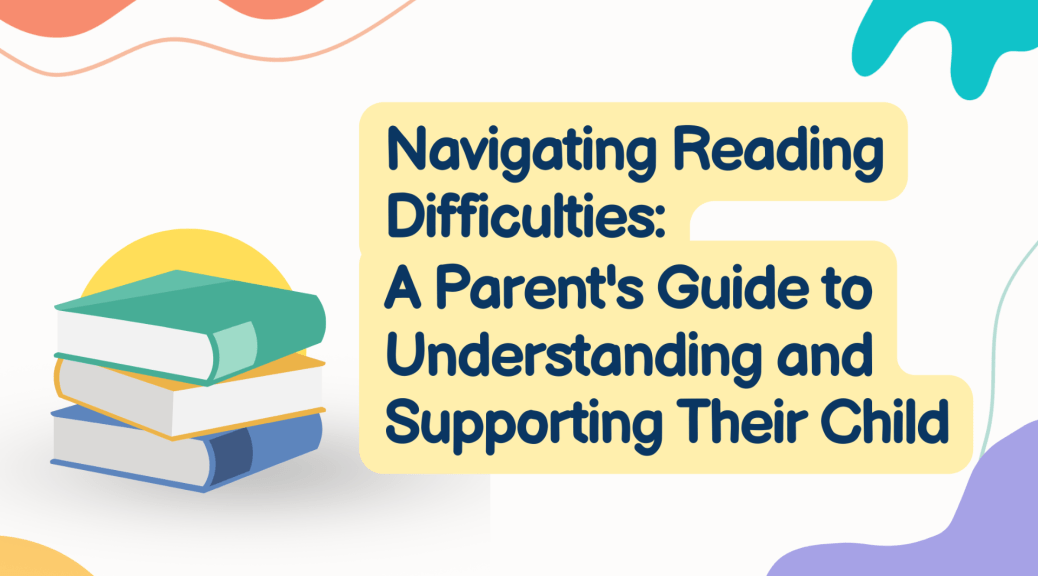
Navigating Reading Difficulties: A Parent’s Guide for their child
As parents, we all want our children to excel in school and develop a love for learning. However, children can sometimes encounter reading difficulties that may make this journey a bit more challenging. In this post, we will explore what reading difficulties are, their prevalence rates in Singapore, how these difficulties can impact your child’s learning in school and provide insights on how to support them effectively.
What Are Reading Difficulties?
Reading difficulties are challenges that children may face when learning to read. These difficulties can manifest in various ways and may affect a child’s ability to read, spell, and comprehend text.
Types of Reading Difficulties:
- Dyslexia: Dyslexia is perhaps the most well-known reading difficulty. It primarily affects a child’s ability to decode words accurately and fluently (Dyslexia Association of Singapore, 2019). Children with dyslexia often struggle with phonological awareness, which is the ability to recognize and manipulate the sounds in words.
- Dysgraphia: Dysgraphia is a writing-specific reading difficulty that affects a child’s handwriting and fine motor skills (National Institute of Neurological Disorders and Stroke, 2023). This can make it challenging for children to express their thoughts on paper, which can hinder both reading and writing skills.
- Reading Comprehension Difficulties: Some children may have difficulty understanding and retaining what they read (Catts et al., 2016). This can lead to problems with comprehension and retention of information from textbooks and classroom lectures.
- Visual Processing Disorders: Visual processing difficulties can make it hard for a child to interpret and make sense of visual information, such as letters and words on a page (Slaghuis et al., 1996). This can significantly impact reading skills.
Prevalence Rates in Singapore
According to a 2017-18 annual report by the Dyslexia Association of Singapore, approximately 10% of the population in Singapore is estimated to have some form of learning difficulty (Dyslexia Association of Singapore, n.d.). This means that in a classroom of 30 students, it’s likely that at least three of them may face reading difficulties. While these figures provide an overview of the prevalence of reading difficulties, it’s essential to remember that each child is unique, and their challenges may vary.
How Reading Difficulties Affect Your Child’s Learning
Reading difficulties can have far-reaching consequences on your child’s academic journey and self-esteem (Boyes et al., 2018; Hamilton & Glascoe, 2006):
- Academic Struggles: Reading difficulties do not only affect learning in language subjects, children with reading difficulties may also perform below their potential in various subjects that require reading, such as mathematics, science and social studies.
- Low Self-Esteem: Repeated struggles with reading can erode a child’s self-confidence and self-esteem, making them feel inadequate or different from their peers.
- Frustration and Anxiety: Reading difficulties can lead to frustration and anxiety in school, as children may face challenges in keeping up with assignments and tests.
- Avoidance of Reading: To avoid embarrassment or frustration, some children may avoid reading altogether, which can hinder their overall learning experience.
Supporting Your Child
It is important to note that reading difficulties are not indicative of a child’s overall intelligence, and most children can overcome them with the right support. As parents, there are several ways you can support your child with reading difficulties (Horowitz-Kraus et al., 2014):
- Early Intervention: Recognize the signs of reading difficulties early and seek help from teachers, specialists, or educational psychologists.
- Tailored Learning Plans: Work with educators to create personalized learning plans that accommodate your child’s specific needs.
- Encourage Reading: Foster a love for reading by providing access to age-appropriate books that cater to your child’s interests.
- Patience and Support: Be patient and empathetic, providing emotional support to help your child navigate their challenges.
- Advocacy: Advocate for your child’s needs within the school system to ensure they receive the necessary accommodations and support.
Conclusion
Reading difficulties are common, and many children in Singapore and around the world face them. Understanding the types of reading difficulties, their prevalence rates, and the potential impact on your child’s learning is the first step towards providing effective support. With early intervention, personalized learning plans, and a nurturing environment, you can empower your child to overcome these challenges and thrive academically and personally. Remember, every child has unique strengths, and with the right support, they can achieve their full potential.
References
Boyes, M. E., Tebbutt, B., Preece, K. A., & Badcock, N. A. (2018). Relationships between reading ability and child mental health: Moderating effects of self‐esteem. Australian Psychologist, 53(2), 125-133. https://doi.org/10.1111/ap.12281
Catts, H. W., Nielsen, D. C., Bridges, M. S., & Liu, Y. S. (2016). Early identification of reading comprehension difficulties. Journal of learning disabilities, 49(5), 451-465. https://journals.sagepub.com/doi/abs/10.1177/0022219414556121
Dyslexia Association Singapore. (n.d.). HELPING DYSLEXIC PEOPLE ACHIEVE. https://www.dasacademy.edu.sg/wp-content/uploads/2022/05/AnnualReport2017_2018.pdf.
Dyslexia Association of Singapore. (2019, March 21). WHAT IS DYSLEXIA? https://www.das.org.sg/about-dyslexia/what-is-dyslexia/what-is-dyslexia.html
Hamilton, S. S., & Glascoe, F. P. (2006). Evaluation of children with reading difficulties. American Family Physician, 74(12), 2079-2086.
Horowitz‐Kraus, T., Vannest, J. J., Kadis, D., Cicchino, N., Wang, Y. Y., & Holland, S. K. (2014). Reading acceleration training changes brain circuitry in children with reading difficulties. Brain and Behavior, 4(6), 886-902. https://doi.org/10.1002/brb3.281
National Institute of Neurological Disorders and Stroke. (2023, January 20). Dysgraphia. https://www.ninds.nih.gov/health-information/disorders/dysgraphia#:~:text=What%20is%20dysgraphia%3F,are%20first%20introduced%20to%20writing.
Slaghuis, W. L., A.J. Twell, & Kingston, K. (1996). Visual and language processing disorders are concurrent in Dyslexia and continue into adulthood. Cortex, 32(3), 413–438. https://doi.org/10.1016/s0010-9452(96)80002-5
Written by: Keval
Edited by: Michelle and Phoebe
Reviewed by: Joyce